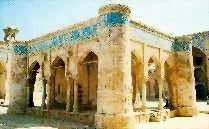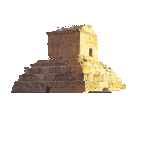|
Shiraz
|
Atiq mosque or Khoda Khane
The ancient Jami Mosque known
also as the Jami or (Friday) mosque, is one of the oldest mosques in Iran
and a relic of the days of the reign of Amr-ebn Leys, the Saffarid. It is
a structure referred to many times in the writings of travelers such as
the Ibn Battuta and Madame Dieulafoy.
The Saffarids were a people of Iranian stock who were originally from the
province of Sistan.
During the course of their sovereignty, that is, from A.D.867 to 903, they
did not neglect the construction of public buildings, of which the Jami
Mosque, is a prime example despite the many conflicts they had with the
Baghdad Caliphs and with local rivals. The construction of the Mosque was
started in A.H. 281 (A.D. 894) as an act of thanksgiving following the
victory of Amr Leys` forces over the armies of the Abbassid Caliph al-Movaffaq.
Through the years, the mosque has witnessed numerous catastrophes, as a
result of which it has been rebuilt and restored many times, for example
in the 12th and 13th century A.D., during the reign of the Atabak rulers
of Fars, and in the 16th through 18th century A.D., during the Safavid
epoch. The restoration of the Jami Mosque has continued during the
auspicious reign of Pahlavi dynasty, with the cooperation of the
Department of Archaeology and the charitable people of Fars province.
The Jami Mosque used to have six portals in different directions and
numerous magnificent (Shabestans) or prayer-halls and chambers, some of
which gradually fell into ruin and are no longer standing.
Formerly the (sahn), or the courtyard of the mosque was carpeted with
marble, and there were stone basins in the vestibules wherein those
entering the mosque would wash their feet before proceeding barefoot onto
the courtyard. The most important portal of the mosque lies on the north
side, and is known as (The twelve Imams).
Its piers and borders are of stone, and the rest is brickwork.
Both sides of the portal are decorated with glazed mosaic tiles.
The decoration consists of beautifully written verses from the Koran and (eslimi)
or arabesque designs with flower-and-bird motifs.
Between this portal and the entrance of the mosque there is a hashti or
(vestibule), around which a number of blind arches can be seen.
The ceiling of this section has been decorated with stalactites in a very
interesting and appealing way, and is ornamented with Qorani verses on all
four sides.
There is also an inscription from the Safavid period here, which is the
work of the famous calligrapher, Ali Jowhari. In the corner of the
inscription appears its date.
Back to
the top
|

Atiq mosque
|




